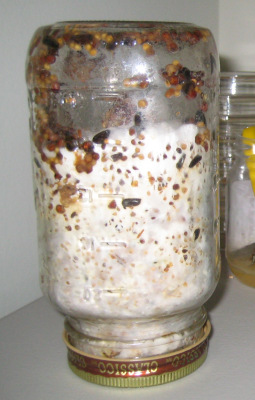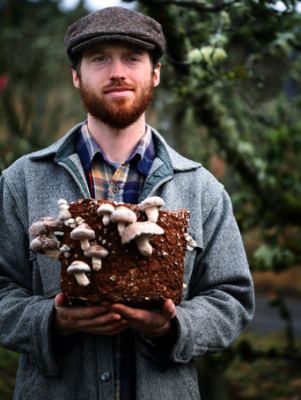
Substrates for mushroom cultivation
 The material which mushrooms are grown on
is known as the substrate. Although some species are very picky,
others (like the oyster mushroom) can be grown on almost anything that
started life as a plant. We'll provide sterilization instructions
for all of these substrates tomorrow. For now, here are recipes
for turning your plant matter into growing media.
The material which mushrooms are grown on
is known as the substrate. Although some species are very picky,
others (like the oyster mushroom) can be grown on almost anything that
started life as a plant. We'll provide sterilization instructions
for all of these substrates tomorrow. For now, here are recipes
for turning your plant matter into growing media.
When commercial growers start their mycelium in a petri dish, they
often expand it into jars of sterilized grain. Millet, rye, and
wheat are most often used, but Paul Stamets reports that any grain will
do. To fill a one quart jar, mix 200 grams of grain, 220 mL of
water, and 1 gram of gypsum (to keep the kernels separated and provide
calcium and sulfur.)
Later, mycelia can be expanded onto a mixed wood substrate made up of
different sizes of chips and sawdust. The fungus will quickly
colonize the smallest sawdust grains, while the larger chips provide
for air flow and allow the fungus to form rhizomorphs that lead to big
mushroms. Paul Stamets recommends using only one species of tree
at a time, if possible, and sticking to fast-growing and -decomposing
species like alder. These trees have more sapwood, which is easy
for your mycelium to colonize quickly. His recipe for sawdust
spawn is very simple --- moisten the sawdust to 60 to 70% water,
sterilize, and innoculate.
 Sawdust and wood chips are a bit hard for
your mushrooms to digest quickly, so if you want to boost your yields
you may choose to supplement them with some source of protein.
Lots of homestead and farm waste products fit the bill, including rice,
wheat, or oat bran; ground corn; grape pumice from wineries; spent
barley from breweries; vegetable oil; and stale bread. Enriching
your substrate, though, is a double-edged sword --- the extra nutrients
also help contaminants grow quickly, so you'll need to double your
sterilization time. Paul Stamets' recipe for enriched sawdust is
as follows: 100 pounds of sawdust, 50 pounds of one half to four inch
wood chips, 40 pounds of bran, and 5 to 7 pounds of gypsum, moistened
to 60 to 65% water and then sterilized.
Sawdust and wood chips are a bit hard for
your mushrooms to digest quickly, so if you want to boost your yields
you may choose to supplement them with some source of protein.
Lots of homestead and farm waste products fit the bill, including rice,
wheat, or oat bran; ground corn; grape pumice from wineries; spent
barley from breweries; vegetable oil; and stale bread. Enriching
your substrate, though, is a double-edged sword --- the extra nutrients
also help contaminants grow quickly, so you'll need to double your
sterilization time. Paul Stamets' recipe for enriched sawdust is
as follows: 100 pounds of sawdust, 50 pounds of one half to four inch
wood chips, 40 pounds of bran, and 5 to 7 pounds of gypsum, moistened
to 60 to 65% water and then sterilized.
The last widely used mushroom substrate is straw --- this is Paul
Stamets' favorite for economical oyster mushroom production. He
chops wheat, rye, oat, or rice straw into 1 to 4 inch lengths, then
pasteurizes it and inoculates.
Although grain, wood chips, and straw are the main substrates used in
commercial mushroom production, you shouldn't stop there! Growing Gourmet and Medicinal
Mushrooms teased me with notes that mushrooms can be grown on
newspaper, cardboard, books, corncobs, corntalks, peanut shells, tea
leaves, coffee grounds, and much more. I hope that by this time
next year I'll have information on the best ways to turn these waste
products into mushrooms!
This post is part of our Growing Gourmet Mushrooms lunchtime series.
Read all of the entries:
|
Want more in-depth information? Browse through our books.
Or explore more posts by date or by subject.
About us: Anna Hess and Mark Hamilton spent over a decade living self-sufficiently in the mountains of Virginia before moving north to start over from scratch in the foothills of Ohio. They've experimented with permaculture, no-till gardening, trailersteading, home-based microbusinesses and much more, writing about their adventures in both blogs and books.
Want to be notified when new comments are posted on this page? Click on the RSS button after you add a comment to subscribe to the comment feed, or simply check the box beside "email replies to me" while writing your comment.
